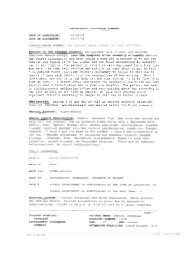C - Organized Mobbing
C - Organized Mobbing
C - Organized Mobbing
Create successful ePaper yourself
Turn your PDF publications into a flip-book with our unique Google optimized e-Paper software.
510 CHAPTER NINE<br />
department's ability to know what was going on and to inform those higher<br />
up before anybody else could. Accordingly, the Stasi paid much attention<br />
improve its recruitment and systematic employment of secret informants,<br />
~ost directives regulating operative work contain a major section outlinin<br />
the implications of work with secret informants, and many key<br />
were entirely dedicated to the recruitment and guidance of secret infor-<br />
mants.'' Directive 1/79 (in Milller-Enbergs 1996,305-73) set the framework<br />
for what was to be considered good work with informants for the ,g80, -.<br />
Through the ways in which it urged officers to recruit and handle inform,,,<br />
- - "'LallLS<br />
effectively, the document reveals how the Stasi understood the people on<br />
whom the success and failure of its work was SO crucially dependent.<br />
Recruiting underground dwellers<br />
The directive reminds officers that the motivations for collaboration with the<br />
secret police among potential and actual informants varies widely and that<br />
officers therefore need to adjust their recruitment strategies and the man-<br />
ner of interaction and collaboration with informants accordingly. The fact<br />
that the Stasi employed roughly 180,ooo informants of all grades and kinds<br />
coming from diverse social, educational, and professional backgrounds un-<br />
derscores this point. The Stasi officers I interviewed were all at one point in<br />
their careers more or less successfully involved in recruiting informants for<br />
whom they became what is known in English spying argot as "handlers:'<br />
or in Stasi lingo as "guidance officers:' They were all familiar with the in-<br />
tricacies of worlung with informants. Considering the motivation of their<br />
own informants the officers agree with official teaching materials that forced<br />
recruitment based on blackmail was relatively ineffective. Such informants<br />
typically worked to rule and frequently they blew their cover intentionally to<br />
end their relationship with the Stasi. Recruitment based on material interest<br />
or other more personal motives (such as revenge) were considered more ef-<br />
fective but also tended to create a dynamic that could be at variance with the<br />
intentions of the Stasi. .All officers complained that they often were wasting<br />
time with ineffective, not properly motivated, or even unmotivatable infor-<br />
mants whom they should have quickly abandoned. Sometimes it was clear<br />
from the beginning that the collaboration would be a tedious affair. An*<br />
yet, the officers were wrestling with recruitment quotas that forced them to<br />
maintain full rolls. Like every other production unit in the country they had<br />
to fulfill (or better, overfulfill) the plan.<br />
40. The standard rvork outlining the development of the Stasi's work with informants from the<br />
beginning of the organization in ,950 to the end in 1990 is Miiller-Enberg's introduction ( 199~~





